LodgeiT is designed to help you prepare tax forms, working papers & financial reports faster & more accurately. In order to help you, LodgeiT requires you to work within a defined framework described by the LodgeiT chart of accounts . Account line items must be classified accurately and in some cases, certain configurations within accounting systems must be adhered to. i.e. salary & wage ledgers must be maintained separately for associated persons & non associated persons.
Unlike most systems, LodgeiT prefers that you import balance sheet & profitLoss accounts. LodgeiT supports automated import of these artifacts and the general ledger detail from some systems like Xero & QuickBooks. For other systems, please investigate our 'extract, transform' tool - LodgeiT Smart excel Utility (Excel plugin) will normalise any accounting system report to a format that LodgeiT can ingest. LodgeiT contains smart validation technology to ensure that the profitLoss & balance sheet reports that are imported, are related so essentially you get a valid trial balance.
We also have our in-house excel if you do not have an accounting system.
Be sure to import comparative year accounts. LodgeiT automation is dependent on comparatives when they are available.
Certain line item types will switch - overdrawn bank accounts classified to bank accounts under cash & cash equivalents will be switched to overdrafts in the liabilities sector. The LodgeiT profitLoss reports are designed to clearly show decreasing adjustments & capital losses in the expenses sector. This is done to provide a more easily digestible report for non-accountants.
Certain whole sectors will switch - Net GST will reflect as either Net GST Receivable or Net GST Payable depending on the net value being either positive or negative.
Explore & familiarise yourself with the LodgeiT Chart of Accounts here. On initial import of any balance sheet & profitLoss report, the LodgeiT automated classifier will do its' best to classify the client-side account line items to the LodgeiT Chart of Accounts. You may need to correct some of the automated classifications.
The following information will help you to configure your client-side accounting ledgers appropriately and classify correctly when you import them to LodgeiT.
ASSETS
Ensure that the banks accounts are properly reconciled to the respective bank statements.
Add accounts receivable/trade debtor balance values especially if you want to convert taxable income to cash basis.

Breakup your plant & equipment into appropriate classifications and ensure that the accumulated depreciation account can be easily associated with the related asset account by naming accounts appropriately. See example below.

The LodgeiT Chart of Accounts explorer contains detailed information in relation to the appropriate classification of depreciable assets so as to conform to ATO Requirements. Use the depreciation calculator learning resources to discover how to use the LodgeiT Depreciation Module.

Example below of the detailed information associated with General Pool i.e. link to the ATO knowledgebase & more.

Take advantage of the LodgeiT Borrowing Cost calculator & Preliminary Expenses/Blackhole calculators to compute & retain a record of the correct amortisation amounts. Classify unexpired capitalised cost line items to the appropriate sub-sectors of the LodgeiT Chart of Accounts.

LIABILITIES
Maintain separate accounts for the ATO tax categories in the image below. A net GST balance is the GST either receivable or payable for the quarter or month in question depending on if the lodger is reporting quarterly or monthly. Any unpaid ATO debt or ATO receivable that relates to a period prior to the reporting period associated with the closing balance sheet balances should always be reflected in an ATO Integrated account client-side line item.

Use the True Balance Validator in situations where the Integrated Account has a balance at 30 June. This will require you to import Integrated Account facts into LodgeiT.
Learn how to use all of the tax Analyser tools via "Report" tab, through this Analysers, it will allow you to better automate the LodgeiT Working Papers.
Company income tax payable should match the company tax return after accounting for income tax instalments. If there is a final outstanding instalment as there often is, that should be classified to a PAYG -I instalment account.
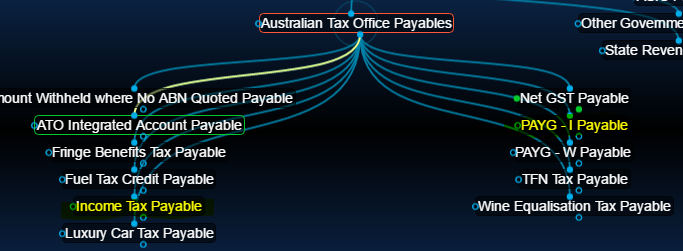
Add accounts payable/trade creditor balance values especially if you want to convert taxable income to cash basis.
Never track government taxes or superannuation through creditors/accounts payable. LodgeiT expects these payable values to be classified to the specific tax liability categories.

Make sure you have correct balances for superannuation liabilities on the balance sheet. LodgeiT creates expense adjustments for unpaid superannuation into the tax expense reconciliation of the tax forms.
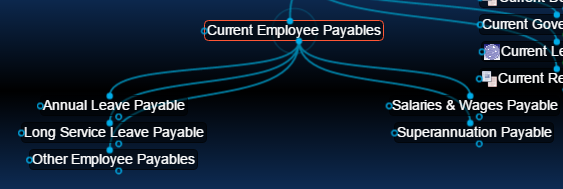
Bank overdrafts & credit card liabilities are to be found under the Loans Payable category.

Both unsecured.

And secured.

Loans from associated persons can be classified into either secured or unsecured liability sectors. For trusts, beneficiary loan balances should be classified to Current Unsecured Loans from Beneficiaries Payable.

Beneficiary accounts can be handled either with line items representing the following highlighted categories for each beneficiary -

Or beneficiary loans can be single line items reflecting the final balance -

Use the LodgeiT Loans Calculators to track interest revenue or costs and loan balances associated with loans payable or receivable.

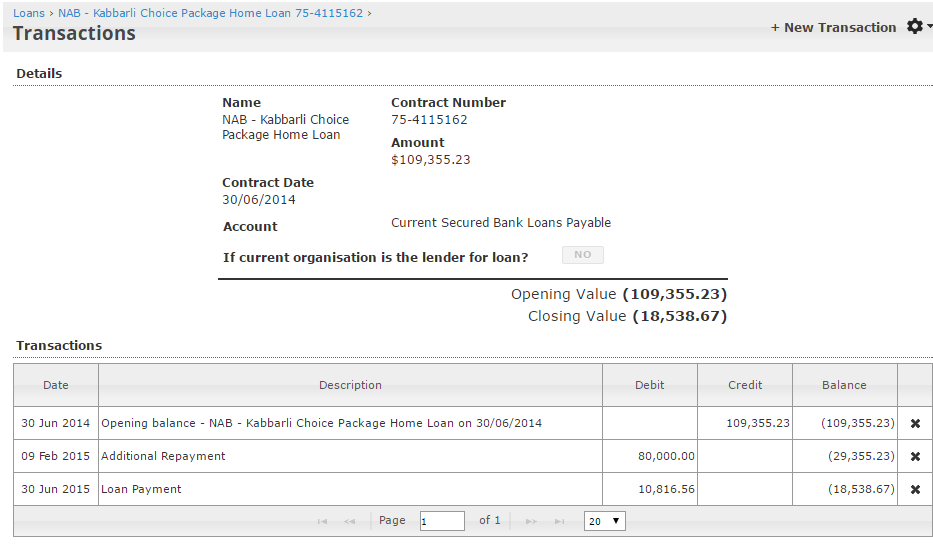
When accounting for hire purchases, consider breaking out each hire purchase into current & non-current liability components as well as outstanding repayments & unexpired interest.


These liability accounts should then match the HP Calculators in LodgeiT.
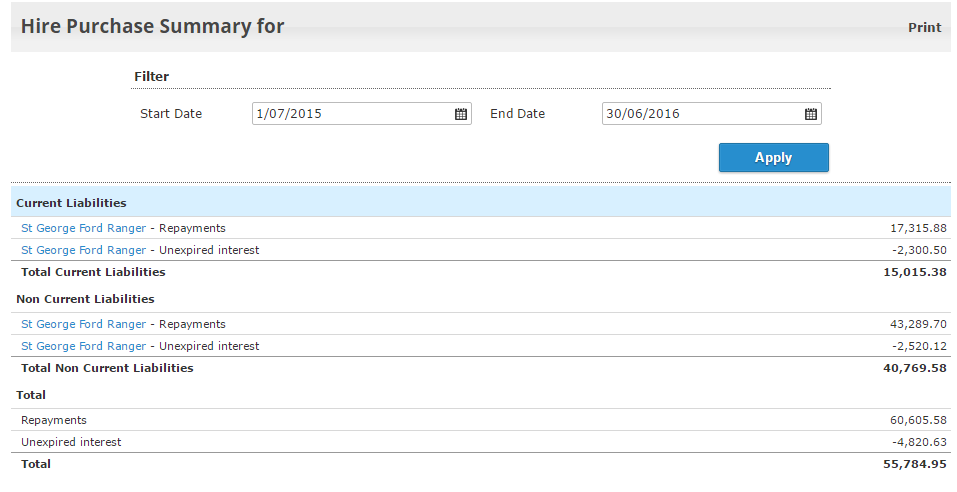
EQUITY
In the case of a company, where profits need to be appropriated as a dividend, create the following entry in your source general ledger system -
(+)Debit Dividends Paid (Classify to Dividends Paid in the LodgeiT System) (-)Credit Profit Appropriation (You will probably need to create this account in the equity sector of your accounting system, then classify to the Historical Earnings sector in the LodgeiT Classifier.) You'll note that net retained earnings is unchanged but at least the dividend transaction is recognised & can be presented in the Financial statements generated by LodgeiT.

For Partnerships,
LodgeiT will roll-up Partners Equity to a single line item & allow full expansion as follows -

LodgeiT Tools allow this configuration to be built directly in the financial report. Or you can import the configuration if you chose to create sub-accounts in the client ledger. We suggest the simpler method of closed account end points, one per partner.
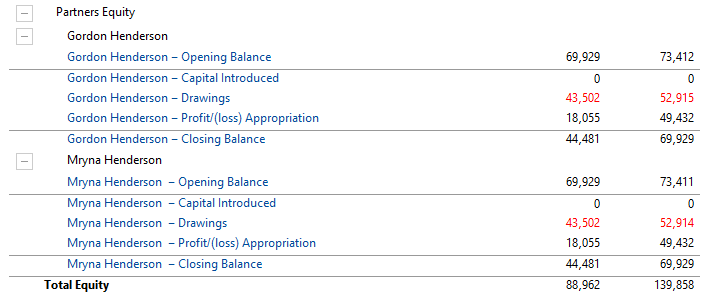
If you select not to import the fully configured report, then simply closeout endpoints for each partner as follows in your source accounting system as follows -

Once again, you will need to create a profit appropriation account. Assuming that you have a profit to attribute to partners in your source accounting system,
Cr Partner A1,A2, etc Dr Profit Appropriation
Naturally, appropriation of a loss will require the opposite journal entry.
Your source accounting system balance sheet will have a credit for accumulated earnings & a debit for profit appropriation. Simply classify both values to a single equity category using the LodgeiT Classifier & your partnership equity section will be left with just the respective partner balances.
Classify Share Capital appropriately so that LodgeiT can use the LodgeiT Share Register values for reconciliation purposes.Learn how to use the LodgeiT Share Register here.

REVENUE
When you have a trading entity selling goods and/or services based on divisible, measurable units of some related input, use Income from trade - Good/Units classification. LodgeiT will then enable inventory tools to assist you in analytical & review-based tasks. This is particularly important in the situation where there are both trade revenue streams with & without relationships with Cost of Goods Sold.

To automate the interest earned reconciliation, consider creating client-side account line items to match each interest-bearing account. Assuming the full client-side general ledger is loaded, LodgeiT will be able to measure interest earned relative to average daily balance & compute the average earnings rate.

For that income classification that appears to have no correspondence to the LodgeiT Chart of Accounts, use Other Income, child of Other Revenue.

Create client-side account line items for capital gains such that the line item can be classified to a sector that matches the asset sector. i.e.Intangibles -->Goodwill, create Capital gain on disposal of goodwill account and classify accordingly. This will help LodgeiT to auto-check the accounts & fill the tax form..

Create client-side account line items for assessable balancing adjustments such that the line item can be classified to a sector that matches the asset sector. i.e. Plant & Equipment -->Motor Vehicles, create Assessable balancing adjustment on disposal of motor vehicles account and classify accordingly. This will help LodgeiT to auto-check the accounts and correctly fill the tax form. In this example, the auto-check will involve the LodgeiT Depreciation Module.

EXPENSES
The LodgeiT Chart of Accounts classification system is designed to accomodate every business type. In some cases, where you do not believe you have an available category in Cost of Goods Sold, use Other Cost of Goods Sold.

In the Cost of Goods Sold sector, LodgeiT has detailed sub-sectors for -
Human Resource Costs. Be sure to separate salary & wage and superannuation line items where payments are made to associates.This is necessary for automating the fill of the tax forms. 
There are categories for contractors & consultants.

Motor Vehicle Expenses. Western Australian users can classify government motor vehicle registration to registration & insurance. Eastern states users can retain registration costs separately.

In indirect costs, the motor vehicle expenses & human resource cost sectors are replicated, so you'll need to be careful to understand the business you are working with & create client-side account line items/classify appropriately to either the COGS or indirect cost sectors.
If the entity operates a rental property, be sure to create client-side account line items for the property expenses so that the line items match the reporting categories used by the ATO. i.e. Stationery, telephone & postage. Additionally, if there is more that one rental property, name the client-side accounts appropriately ie. Cleaning - 3 Regal Rd, Cleaning - 15 Edward St. If you fail to do this, you'll not be able to use the LodgeiT rental property schedule auto-fill tools. Capital works & capital allowances associated with rental properties must be classified to the rental property costs child sectors.
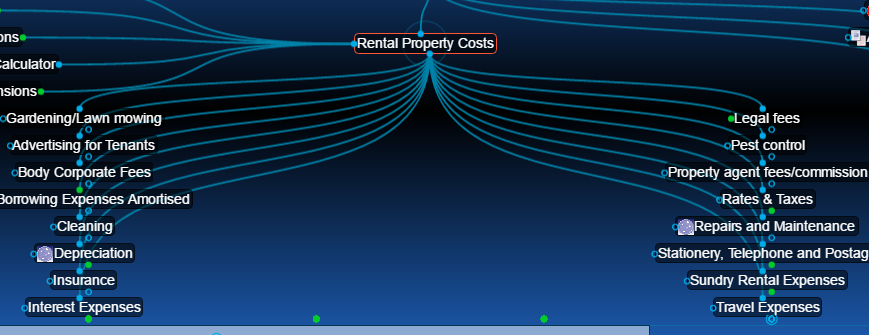
For capital losses & deductible balancing adjustments, please read about capital gains & assessable balancing adjustments above under REVENUE. LodgeiT will automatically switch negative value line items classified to the revenue sectors to the expense sector categories named here to minimise the confusion of novice account readers.
Capital Losses.

Deductible Balancing Adjustments.

Create & classify client-side expense line items for amortised expenses to the appropriate child categories of amortisation costs. Refer back to the end of the asset information section above to ensure that the asset aspect of unexpired capitalised costs are treated correctly. Take advantage of the LodgeiT Borrowing Cost calculator & Preliminary Expenses/Blackhole calculators to compute & retain a record of the correct amortisation amounts.
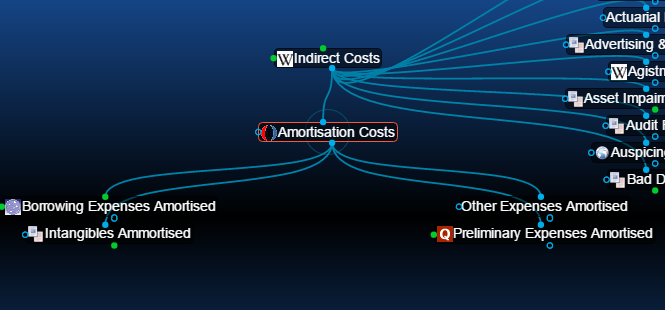
Depreciation must be handled correctly in order for the LodgeiT automation systems to work effectively. Use the depreciation calculator learning resources to discover how to use the LodgeiT Depreciation Module. Most importantly, be sure to create client-side line item accounts dedicated to each depreciation type i.e. one account for general pool write off and another for capital works (building depreciation).
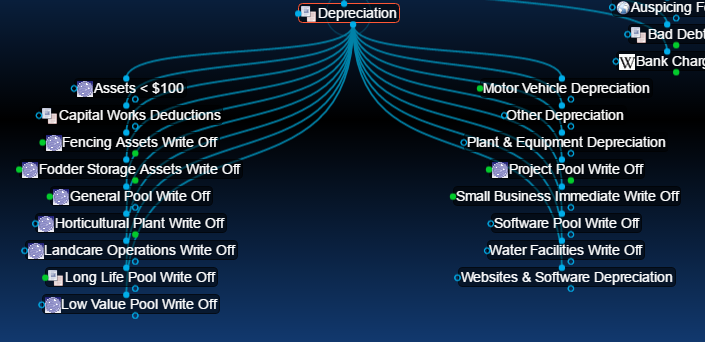
Usually, research & development expenditure is spread across multiple client-side account line items. Whenever possible, attempt to create sub-accounts where R&D expenditure can be accounted for separately from non-R&D related costs in the client-side accounting system. This approach will allow you to classify all R&D-related account line items using the LodgeiT account tagging system.

The LodgeiT Chart of Accounts Classifier also contains a specific R&D Category for those client-side account line items that are named R&D and cannot be classified elsewhere. For automating the R&D schedules, client-side account line items classified here must still be tagged.

The following LodgeiT Chart of Account Expense categories have child categories for the following reasons -
Likely to come under increased scrutiny during the review process
-Helps accountants & bookkeepers to be careful with expense classifications to these categories
-Segments costs into smaller, easier to review sub-sets
-Allows us to provide categorisation examples
-Will prove useful for future automation of the review function as the LodgeiT general ledger natural language processing project advances
-Bank Charges. Consider creating client-side line items for merchant bank fees. This will make it easier to check that the appropriate tax codes have been applied to expenses in the general ledger detail reports.

Consumables. Where a business utilises consumables consider creating specific client-side line items. For line items that cannot be classified to the named LodgeiT categories, use other consumables. Do not classify cost of goods here.

Fees & Charges. Fees & charges is an ambiguous category since there are traditional fee types that have their own categories including accounting fees, audit fees and bookkeeping fees to name a few. Examples of the types of fees & charges that are typically categorised here are noted as children of fees & charges. Note that regulatory filing fees is a subcategory of fees & charges in the LodgeiT chart of accounts. Other fees & charges is a general catch-all.

Insurance. Create client-side account line items for the various classes of insurance. This is a great way to ensure that bookkeepers think carefully about appropriate classification and this helps with generating concise working papers and finding prepayments of insurance. Use the other insurances category for insurance line items that are not contextual.
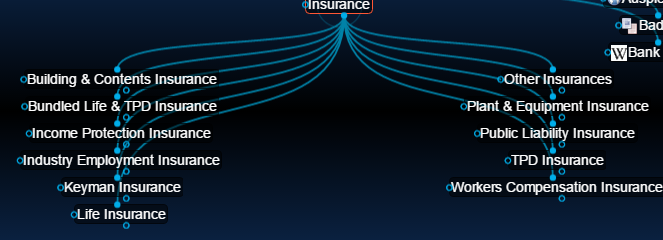
Fines & Penalties. Segmenting according to the structure below will allow for ATO penalties to be tested back against the ATO tax & integrated accounts.

Rates & Taxes. Segmenting according to the structure below will facilitate easier general ledger reviews.

Repairs & Maintenance. Repairs & maintenance can easily end up as a dumping ground so be careful with classification to this category & be sure not to include capital assets here.

Subscriptions & Memberships. As more digital services are consumed by businesses, consider classifying software subscriptions to a dedicated software subscription account rather than the ambiguous computer expenses category.

Telecommunications. Not long ago, accountants used to create an account for telephone. Now telecommunications incorporates a range of alternative methods of connecting people & machines for telecommunication-based purposes. It is quite common now for a range of services to be bundled into a single telecommunications charge.

Travel. Travel costs come under significant regulatory scrutiny. Consider keeping international travel costs separate from national travel costs. This is not a sector for classifying travel allowances. Travel allownaces for part of salary & wages & need to be reported on employee group certificates.
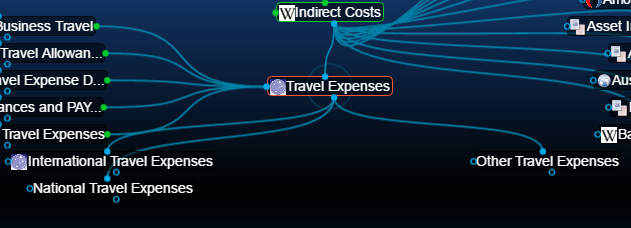
Utilities. Split-out gas & electricity costs to make the review process easier.

Classify company income tax expenses to income tax expense.

Classify payroll tax & employee long service leave board payments to the following employee cost categories. This allows LodgeiT to assist in testing payroll tax percentages & allows report consumers to appreciate the full cost of human resources.
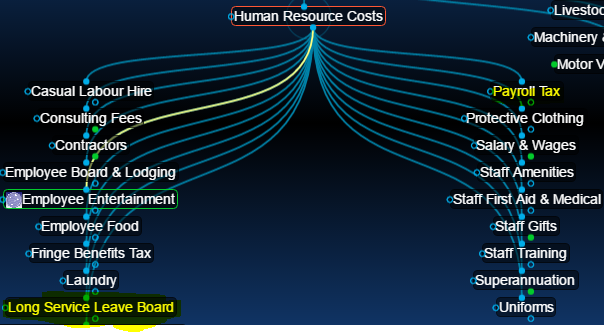
Enclosed the excel of LodgeiT standard "chart of accounts"
Related articles:
Understanding LodgeiT Chart of Accounts
Getting Started with Mapping Accounts
